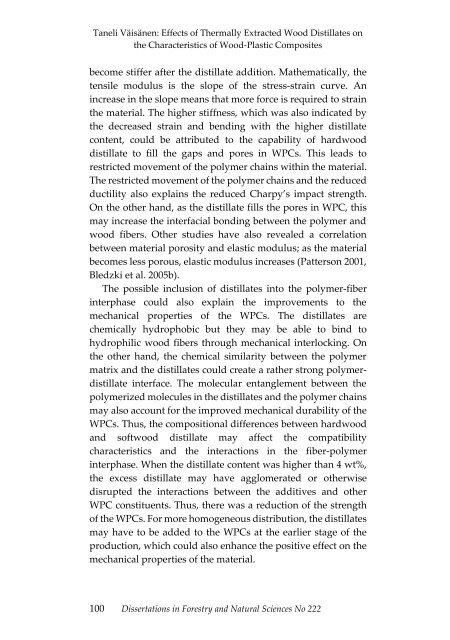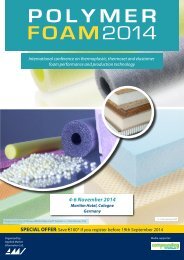Dissertations in Forestry and Natural Sciences
24lYKFN
24lYKFN
Create successful ePaper yourself
Turn your PDF publications into a flip-book with our unique Google optimized e-Paper software.
Taneli Väisänen: Effects of Thermally Extracted Wood Distillates on<br />
the Characteristics of Wood-Plastic Composites<br />
become stiffer after the distillate addition. Mathematically, the<br />
tensile modulus is the slope of the stress-stra<strong>in</strong> curve. An<br />
<strong>in</strong>crease <strong>in</strong> the slope means that more force is required to stra<strong>in</strong><br />
the material. The higher stiffness, which was also <strong>in</strong>dicated by<br />
the decreased stra<strong>in</strong> <strong>and</strong> bend<strong>in</strong>g with the higher distillate<br />
content, could be attributed to the capability of hardwood<br />
distillate to fill the gaps <strong>and</strong> pores <strong>in</strong> WPCs. This leads to<br />
restricted movement of the polymer cha<strong>in</strong>s with<strong>in</strong> the material.<br />
The restricted movement of the polymer cha<strong>in</strong>s <strong>and</strong> the reduced<br />
ductility also expla<strong>in</strong>s the reduced Charpy’s impact strength.<br />
On the other h<strong>and</strong>, as the distillate fills the pores <strong>in</strong> WPC, this<br />
may <strong>in</strong>crease the <strong>in</strong>terfacial bond<strong>in</strong>g between the polymer <strong>and</strong><br />
wood fibers. Other studies have also revealed a correlation<br />
between material porosity <strong>and</strong> elastic modulus; as the material<br />
becomes less porous, elastic modulus <strong>in</strong>creases (Patterson 2001,<br />
Bledzki et al. 2005b).<br />
The possible <strong>in</strong>clusion of distillates <strong>in</strong>to the polymer-fiber<br />
<strong>in</strong>terphase could also expla<strong>in</strong> the improvements to the<br />
mechanical properties of the WPCs. The distillates are<br />
chemically hydrophobic but they may be able to b<strong>in</strong>d to<br />
hydrophilic wood fibers through mechanical <strong>in</strong>terlock<strong>in</strong>g. On<br />
the other h<strong>and</strong>, the chemical similarity between the polymer<br />
matrix <strong>and</strong> the distillates could create a rather strong polymerdistillate<br />
<strong>in</strong>terface. The molecular entanglement between the<br />
polymerized molecules <strong>in</strong> the distillates <strong>and</strong> the polymer cha<strong>in</strong>s<br />
may also account for the improved mechanical durability of the<br />
WPCs. Thus, the compositional differences between hardwood<br />
<strong>and</strong> softwood distillate may affect the compatibility<br />
characteristics <strong>and</strong> the <strong>in</strong>teractions <strong>in</strong> the fiber-polymer<br />
<strong>in</strong>terphase. When the distillate content was higher than 4 wt%,<br />
the excess distillate may have agglomerated or otherwise<br />
disrupted the <strong>in</strong>teractions between the additives <strong>and</strong> other<br />
WPC constituents. Thus, there was a reduction of the strength<br />
of the WPCs. For more homogeneous distribution, the distillates<br />
may have to be added to the WPCs at the earlier stage of the<br />
production, which could also enhance the positive effect on the<br />
mechanical properties of the material.<br />
100 <strong>Dissertations</strong> <strong>in</strong> <strong>Forestry</strong> <strong>and</strong> <strong>Natural</strong> <strong>Sciences</strong> No 222



